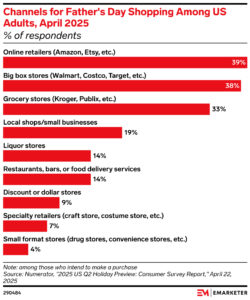It’s that time of the year when we honor all the dads and father figures worldwide. Here are some trends shaping Father’s Day advertising for 2025.
Father’s Day in 2025 is just around the corner (most especially in North America), and brands are getting creative in how they connect with modern dads and those shopping for them. Here are some advertising trends shaping Father’s Day marketing in 2025 and what brands can learn from these key insights.
Higher spending on Father’s Day presents
According to an annual survey by the National Retail Federation and Proper Insights & Analytics, Father’s Day spending is projected to hit an all-time high of $24 billion in 2025. This marks a jump from $22.4 billion in 2024 and surpasses the previous record of $22.9 billion set in 2023.
Almost half of consumers (48%) plan to buy a gift for a father or stepfather, while others are shopping for husbands (25%), sons (12%), brothers (9%), friends (8%), or grandfathers (6%). As in previous years, the majority of people—76%—intend to celebrate Father’s Day. Shoppers expect to spend an average of $199.38 each, nearly $10 more than last year. Consumers aged 35 to 44 are leading the way, averaging $278.90 in spending, up $27 from 2024.
In addition, an April 2025 eMarketer survey found that majority of US adults plan to shop for Father’s Day gifts online and various big box and retail stores:

To keep up with changing shopper behaviors, advertisers must evolve their strategies, especially by enhancing or expanding their omnichannel advertising approach.
As Retail Dive notes, “Omnichannel has grown beyond simply connecting online and in-store experiences. In 2025, it’s about offering adaptive, hyper-personalized journeys that anticipate customer needs at every interaction.”
Adding a good mix and variety of connected TV (CTV), digital out-of-home (DOOH), and out-of-home advertising strategies can ensure you’re reaching to both online and offline consumers and engaging them at every stage of the customer journey.
Going personal is the way to go
Moreover, the NRF survey showed that shoppers are prioritizing gifts that feel unique or help create lasting memories this Father’s Day. Popular choices include: greeting cards, clothing, special outings, and gift cards.
Experiences and personal touches are gaining traction, with more consumers opting for outings, self-care items, and subscription boxes. This year, 43% plan to give a subscription box (up from 34% in the previous year and 30% will gift an experience, rising from 23% in the previous years.
That said, brands should opt for more personalized audience targeting and contextual targeting, to ensure that ads are actually relevant and valuable to users. It’s a little game of “matchmaking” if you will – your product or service may just be offering that perfect present for those who are actually searching for specific keywords on what they may get for Father’s Day.
Last minute Father’s Day shopping is a thing
According to NielsenIQ, Father’s Day shopping tends to happen in a short window, with nearly 90% of consumers planning to make their purchases within the month leading up to the holiday. Notably, about 25% wait until the final week, creating a spike in last-minute buying.
To capitalize on this, brands should be ready with targeted offers and messaging that appeals to late shoppers. Sending last minute reminders can also be impactful. Use a countdown approach that highlights key shipping deadlines to create urgency. Time-sensitive reminder emails are proven to drive strong conversion rates, making them a powerful tool in the final days of Father’s Day campaigns.
In contrast, engaging users with a variety of products early can be quite helpful for those who may have their eye on certain items but haven’t jumped the gun on purchasing. Capturing user interest early with a range of classic Father’s Day gift options can help trigger browse and cart abandonment email flows, giving brands the opportunity to re-engage shoppers who are likely comparing options across multiple sites in search of the perfect gift.
Social media and user-generated content take center stage
Consumer decisions are shaped by both in-store visits and online browsing. NielsenIQ also found that 69% plan to shop in physical stores, while 66% will browse online. Social media platforms like Instagram, TikTok, and YouTube also play a major role in influencing gift ideas. To stay competitive, brands should use these channels to inspire shoppers and drive engagement during the lead-up to Father’s Day.
Consider making video ads that show a little bit of more humor and authentici storytelling in the content. Leveraging user-generated content (UGC) can also make your brand stand out and turns the spotlight on the consumers (in this case, the fathers and father figures), rather than the brand. Since Father’s Day is a seasonal celebration that is often more personal, it boosts engagement and taps into genuine customer stories that create an emotional impact rather than something that’s transactional.
Inclusivity and sensitivity are the way to go
In today’s landscape, brands are increasingly being more mindful and sensitive with the ads and content they deliver to their customers. Inclusive advertising and ethical marketing have been more prevalent in this year’s ads.
Email marketing continues to deliver one of the strongest returns on investment for Father’s Day campaigns this year, with open rates averaging 12–15% higher than usual in the three weeks before the holiday.
Keep in mind that Father’s Day can be a sensitive time for some individuals, and not everyone will want to receive messages about it—even from brands they love. In the push for engagement and conversions, give your customers the option to opt out of Father’s Day-related emails and texts, while still staying subscribed to other promotions and updates they care about. According to Klaviyo, thoughtful brands are now sending pre-campaign emails that give customers the option to opt out of Father’s Day messages and reminders.
Consider also including other regions in your Father’s Day advertising strategies. Father’s Day is also celebrated on various dates around the world. While many countries typically mark the occasion on the third Sunday of June (like in North America), others regions such as Australia, New Zealand, and several European nations, celebrate at different times throughout the year.
Instead of viewing this as a challenge, consider it a strategic opportunity to extend your Father’s Day marketing and drive sales year-round. Segment your audience by location and time your campaigns to align with each country’s local celebration. Be sure to factor in shipping timelines and offer flexible delivery options for international customers.

To see more from illumin, be sure to follow us on Twitter and LinkedIn where we share interesting news and insights from the worlds of ad tech and advertising.











